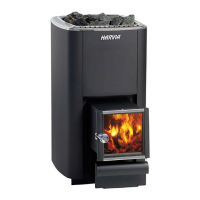EN DE
14
4.2.2. Connecting the Stove to a Masonry Flue
See figure 8. Make an opening in the fireproof wall
for the flue connection. Notice that the opening has
to be at the correct height, if you intend to use,
for instance, a protective bedding. The hole should
be slightly larger than the flue connecting pipe. A
suitable gap around the connection pipe is ca. 10 mm.
It is advisable to round off the inner corners of the
flue opening to ensure that the combustion gases
can flow freely to the flue. Additional accessories
are available to make the installation easier (
4.4.).
You will need an angled smoke pipe (45° or 90°)
for the upper connection (
4.4.).
1. Attach the flue connection pipe to the upper
connection opening. Ensure that the pipe fits
tightly in place.
2. Push the stove in place. Do not block the flue
by pushing the flue connection pipe too far into
the flue. If necessary, shorten the pipe.
3. Seal the flue connection pipe to the opening
in the fireproof wall, for example, by using
fireproof mineral wool. Make sure that the flue
connection is tightly sealed. Add more fireproof
mineral wool if necessary.
4.2.2. Anschluss des Ofens an einen gemauerten
Rauchfang
Siehe Abbildung 8. Stellen Sie in der Brandmauer eine
Öffnung für den Abzugsanschluss her. Beachten Sie,
falls Sie z.B. eine Schutzplatte anzubringen geden-
ken, dass sich die Öffnung auf der richtigen Höhe
befinden muss. Das Loch sollte etwas größer sein
als der Durchmesser des Abzugsanschlussrohres.
Eine Dichtungslücke von etwa 10 mm um das Rohr
herum ist angemessen. Es ist ratsam, die inneren
Ecken der Rauchfangsöffnung abzurunden, damit die
Rauchgase in den Rauchfang frei abziehen können.
Zur einfacheren Montage steht zusätzliches Zubehör
zur Verfügung (
4.4.).
Für den Anschluss wird ein Winkelrauchrohr (45°
oder 90°) benötigt (
4.4.).
1. Bringen Sie das Abzugsanschlussrohr an die
obere Anschlussöffnung an. Das Rohr muss
fest an seinem Platz sitzen.
2. Schieben Sie den Ofen an seine Position. Schie-
ben Sie das Abzugsanschlussrohr nicht zu weit
in den Rauchfang hinein. Kürzen Sie das Rohr,
falls notwendig.
3. Dichten Sie das Abzugsanschlussrohr in der
Öffnung der feuerfesten Wand ab, z.B. mit
feuerfester Mineralwolle. Der Abzugsanschluss
muss absolut dicht sein. Fügen Sie gegebenen-
falls mehr Mineralwolle hinzu.
20 Duo
36 Duo
50 SL
-* -*
M3 SL
20 SL Boiler
20 SL
640
670
670
670
750
1090
830
850
850
850
930
1230
1070
1080
1080
1080
1200
1500
1380
1410
1410
1410
1490
1630
1640
1640
1640
1760
120
120
120
120
130
580
195
215
215
215
255
255
D
A
B
C
ABC
E
F
G
VL22l VL22l
~50 ~50
* smoke pipes/Ofenrohre Ø140 mm
D
ca.
E
ca.
F
ca.
G
ca.
Figure 8. Connecting the stove to a masonry flue (all dimensions in millimeters)
Abbildung 8. Anschluss des Ofens an einen gemauerten Rauchfang (alle Abmessungen in Millimetern)
4.2.3. Connecting the Stove to a Harvia Steel
Chimney
A CE-marked Harvia steel chimney can be used
to remove combustion gases. Its smoke pipes are
made of stainless steel and the chimney has been
insulated for fire safety. The chimney has a round
cross section. The smoke pipe diameter is 115 mm,
and the outer casing is 220 mm.
Connect the steel chimney’s smoke pipe to the
4.2.3. Anschluss des Ofens an einen Harvia-Edel-
stahlschornstein
Zur Abführung der Verbrennungsgase kann ein CE-
geprüfter Harvia-Stahlschornstein verwendet wer-
den. Die Ofenrohre sind aus rostfreiem Stahl gefer-
tigt, und der Schornstein wurde feuerfest isoliert.
Der Schornstein hat ein rundes Profil. Das Ofenrohr
misst 115 mm im Durchmesser und der Außenman-
tel 220 mm.

